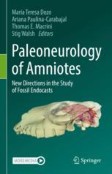Search
Search Results
-
Mating behavior and reproductive morphology predict macroevolution of sex allocation in hermaphroditic flatworms
BackgroundSex allocation is the distribution of resources to male or female reproduction. In hermaphrodites, this concerns an individual’s resource...

-
A trait-based approach to seasonal dynamics of an alpine and subalpine passerine bird assemblage
The bird assemblages in high mountain ecosystems exhibit dramatic seasonal changes in community structure following the sequential arrival of species...

-
The relationship between sternum variation and mode of locomotion in birds
BackgroundThe origin of powered avian flight was a locomotor innovation that expanded the ecological potential of maniraptoran dinosaurs, leading to...

-
Functional morphology of plesiadapiform distal phalanges and implications for the evolution of arboreality in Paleogene euarchontans
With a few exceptions, crown-clade Primates differ from other arboreal mammalian clades by having nails instead of claws on most post-axial digits....

-
Contrasting Brains and Bones: Neuroanatomical Evolution of Turtles (Testudinata)
Turtles are relatively species-poor, but anatomically very distinct from other reptiles, which yields longstanding debates about their origin among...
-
Homo sapiens and Neanderthals share high cerebral cortex integration into adulthood
There is controversy around the mechanisms that guided the change in brain shape during the evolution of modern humans. It has long been held that...

-
Translation stalling proline motifs are enriched in slow-growing, thermophilic, and multicellular bacteria
Rapid bacterial growth depends on the speed at which ribosomes can translate mRNA into proteins. mRNAs that encode successive stretches of proline...

-
Genomic Gigantism is not Associated with Reduced Selection Efficiency in Neotropical Salamanders
Genome size variation in eukaryotes has myriad effects on organismal biology from the genomic to whole-organism level. Large genome size may be...

-
Noise constrains the evolution of call frequency contours in flowing water frogs: a comparative analysis in two clades
BackgroundThe acoustic adaptation hypothesis (AAH) states that signals should evolve towards an optimal transmission of the intended information from...

-
Crop origins explain variation in global agricultural relevance
Human food production is dominated globally by a small number of crops. Why certain crops have attained high agricultural relevance while others have...

-
Evolutionary genetics of pulmonary anatomical adaptations in deep-diving cetaceans
BackgroundCetaceans, having experienced prolonged adaptation to aquatic environments, have undergone evolutionary changes in their respiratory...

-
Support for a radiation of free-living flatworms in the African Great Lakes region and the description of five new Macrostomum species
BackgroundThe African Great Lakes have long been recognized as an excellent location to study speciation. Most famously, cichlid fishes have radiated...

-
Sex determination systems in reptiles are related to ambient temperature but not to the level of climatic fluctuation
BackgroundVertebrates exhibit diverse sex determination systems and reptiles stand out by having highly variable sex determinations that include...

-
Exceptionally simple, rapidly replaced teeth in sauropod dinosaurs demonstrate a novel evolutionary strategy for herbivory in Late Jurassic ecosystems
BackgroundDinosaurs dominated terrestrial environments for over 100 million years due in part to innovative feeding strategies. Although a range of...

-
Cranial Anatomical Integration and Disparity Among Bones Discriminate Between Primates and Non-primate Mammals
The primate skull hosts a unique combination of anatomical features among mammals, such as a short face, wide orbits, and big braincase. Together...

-
Evolution of sexual size dimorphism and sexual segregation in artiodactyls: the chicken or the egg?
In mammals, the dominant theory postulates a causal link between three sexual characters: first, sexual selection promoted the evolution of polygyny;...

-
Investigating the land-to-sea transition in carnivorans from the evolution of sacrum morphology in pinnipeds
The form and function of the sacrum are of great relevance to understand the evolution of locomotion in tetrapods because it is a key piece of the...

-
The Effects of Ecological Traits on the Rate of Molecular Evolution in Ray-Finned Fishes: A Multivariable Approach
Myriad environmental and biological traits have been investigated for their roles in influencing the rate of molecular evolution across various...

-
Phenology determines leaf functional traits across Rhododendron species in the Sikkim Himalaya
Elevation gradients provide an ideal setting to infer species' functional trait responses to predicted future climate change. In plants, leaf...

-
Butterfly population trends track vegetation encroachment but not climate warming in a Mediterranean mountain
Climate and land cover changes are known to exert strong pressure on mountain biodiversity, but the potential interactions between these drivers...

